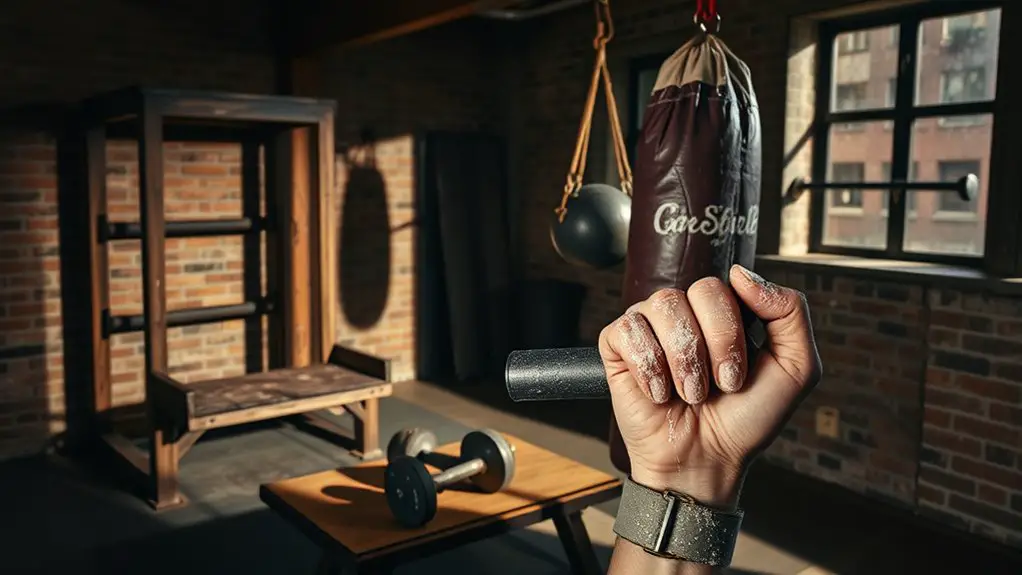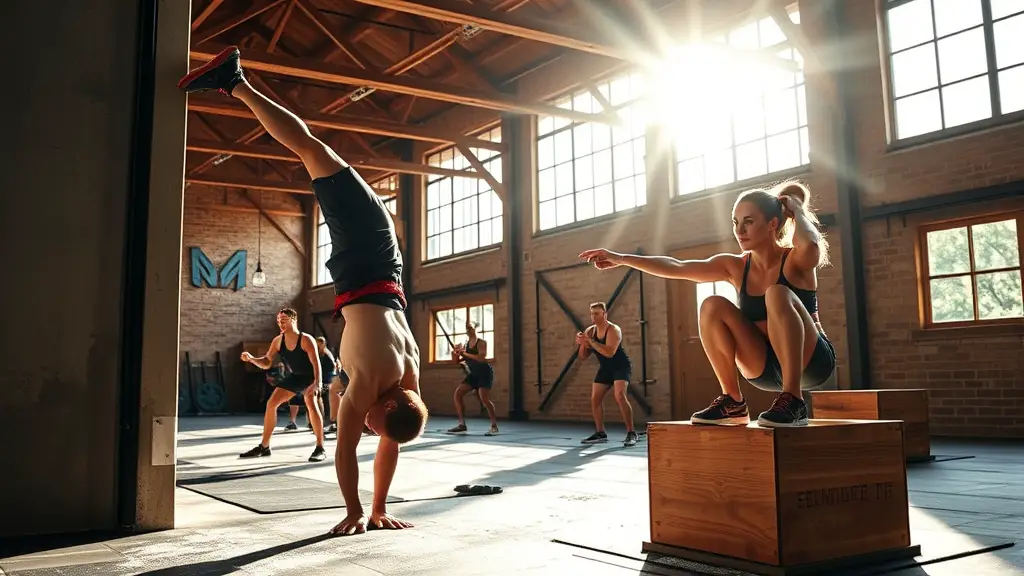The Best Old-School Gym Training Techniques That Still Work

Old-school gym training techniques focus on compound movements, like squats and deadlifts, which engage multiple muscle groups for maximum strength gains. Using free weights helps improve stability and functional strength, while bodyweight exercises enhance endurance and coordination. Mastering proper form and keeping track of your progress are essential for effectiveness and safety. Don’t forget the importance of rest, recovery, and nutrition principles. Continue exploring these timeless methods to access even greater potential in your fitness journey.
The Power of Compound Movements

When you think about building strength and muscle, compound movements should be at the forefront of your training. These compound exercises engage multiple muscle groups at once, making them incredibly efficient for strength gains. Whether it’s squats, deadlifts, or bench presses, these movements work in harmony to promote overall muscle growth and functional strength.
Emphasizing Proper Form
When you’re hitting the gym, proper form is key to maximizing your results and preventing injuries. Focusing on alignment, mastering your breathing techniques, and developing a strong mind-muscle connection can elevate your workouts to a whole new level. Remember, it’s not just about lifting heavy; it’s about lifting smart!
Importance of Alignment
Proper alignment is essential for maximizing your workout effectiveness and preventing injuries. When you focus on alignment techniques, you guarantee that your body moves as it should, allowing you to lift heavier and perform better. Not only does this enhance your strength gains, but it also minimizes strain on your joints and muscles. The alignment benefits extend beyond injury prevention; they also lead to improved posture and overall body mechanics. Remember, even the most intense workouts won’t yield results if your form is off. So, take the time to master your alignment through each movement. You’ll find that with proper alignment, you’ll not only feel stronger but also more confident in your training journey. Keep pushing—your body will thank you!
Breathing Techniques Matter
While you might focus on lifting and technique during your workouts, breathing techniques are just as essential for achieving ideal performance. Mastering diaphragmatic breathing can greatly enhance your strength training. By engaging your diaphragm, you’re not only improving oxygen intake but also stabilizing your core, which is important for maintaining proper form.
Breath control plays a significant role in how effectively you execute each lift. Inhale during the lowering phase to prepare your body and exhale forcefully while pushing through the lift. This rhythm helps you maintain focus and power, allowing you to push your limits safely. So, don’t overlook your breathing; it’s a game-changer. Prioritize your breath, and you’ll see improvements in your overall performance and results.
Mind-Muscle Connection
Tapping into the mind-muscle connection can transform your workouts by ensuring you’re not just going through the motions. It’s all about developing muscle awareness and engaging the target muscles fully. Here are three focus drills to enhance your experience:
- Slow Down Your Reps: Take your time on both the concentric and eccentric phases. Feel each contraction.
- Visualize the Muscle: Before each lift, picture the muscle working. Imagine it contracting and expanding.
- Use a Lighter Weight: Reducing the weight allows you to concentrate on form and really connect with the muscle.
The Importance of Consistency
Consistency is the cornerstone of any successful training regimen, especially when it comes to old-school gym techniques. It’s not just about hitting the gym; it’s about establishing effective training habits that you can stick to over time. When you show up regularly, you’ll build strength and endurance, leading to impressive results.
To maintain this consistency, implement motivational techniques that resonate with you. Whether it’s setting small, achievable goals or finding a workout buddy to keep you accountable, these strategies can transform your mindset. Remember, progress doesn’t happen overnight, and it’s the daily commitment that shapes your fitness journey. Additionally, increased strength can serve as a strong indicator of your consistent efforts in the gym.
Progressive Overload: The Key to Growth

If you want to see real progress in your training, embracing progressive overload is essential. By gradually increasing the weight you lift, you push your muscles to adapt and grow stronger over time. Stick with it, and you’ll be amazed at how consistent effort leads to impressive results!
Gradual Weight Increase
While many gym-goers focus on perfecting their form and increasing their workout intensity, the true cornerstone of muscle growth lies in the principle of gradual weight increase, commonly known as progressive overload. To harness this power, you should implement incremental progression in your training routine. Here’s how to start:
- Assess Your Current Weights: Determine what you’re lifting now, ensuring it challenges you without compromising form.
- Plan Incremental Increases: Choose a weight selection strategy, adding small increments—like 2.5 or 5 pounds—each week.
- Track Your Progress: Keep a workout journal to monitor your gains, celebrating each milestone as you build strength.
Consistent Training Adaptation
As you commence on your fitness journey, understanding the concept of consistent training adaptation is crucial for revealing your full potential. Progressive overload is the cornerstone of consistent progression, where you gradually increase weights, reps, or intensity to push your limits. This approach not only stimulates muscle growth but also enhances strength and endurance.
However, don’t forget the importance of training variety. Mixing up your workouts keeps things fresh and challenges your body in new ways. Incorporate different exercises, rep ranges, and modalities to prevent plateaus and maintain motivation. Remember, it’s the consistent adaptation to these challenges that will lead to significant results. Embrace the grind, stay committed, and watch your progress unfold as you adapt and grow stronger!
Utilizing Free Weights
Free weights have long been a cornerstone of effective strength training, offering a versatile way to build muscle and enhance overall fitness. By incorporating dumbbell exercises and barbell training into your routine, you can release your strength potential. Here are three fantastic ways to utilize free weights:
- Dumbbell Press: Target your chest and triceps while improving stability and coordination.
- Barbell Squats: Engage your entire lower body and core, boosting functional strength and muscle mass.
- Dumbbell Rows: Build back strength and improve posture, essential for balance in your workouts.
Using free weights not only challenges your muscles but also engages supporting muscles, leading to greater overall strength. So grab those dumbbells and barbells, and remember, consistency is key. You’ll be amazed at the transformation that awaits you!
The Benefits of Bodyweight Exercises

Bodyweight exercises offer an incredible way to build strength and endurance, especially when you want to work out without the need for equipment. The bodyweight benefits are numerous; they enhance your functional strength, helping you perform daily activities with greater ease. Exercises like push-ups, squats, and planks engage multiple muscle groups, promoting coordination and stability.
Plus, they’re highly adaptable to your fitness level. Whether you’re a beginner or an advanced athlete, you can modify these movements to challenge yourself. Consistent practice not only improves muscle tone but also boosts cardiovascular health and flexibility.
You don’t need a gym membership or fancy gear—just your body and a bit of space. So why not embrace the simplicity of bodyweight training? It’s a time-efficient, effective way to get fit and stay strong. Start incorporating these exercises into your routine, and watch your strength skyrocket!
Embracing Simple Nutrition Principles
To maximize the benefits of your workouts, it’s important to pay attention to what you fuel your body with. Simple nutrition principles can make a significant difference in your performance and recovery. Focus on these key aspects:
- Meal Timing: Eat a balanced meal or snack about 30-60 minutes before your workout. This helps optimize energy levels and enhance performance.
- Nutrient Density: Prioritize foods rich in vitamins, minerals, and macronutrients. Think of colorful vegetables, lean proteins, and whole grains that support your body’s needs.
- Hydration: Don’t forget to drink water throughout the day, especially before and after your workouts. Proper hydration aids in recovery and keeps your energy up.
The Role of Rest and Recovery

While it might seem tempting to push through workouts without taking breaks, rest and recovery are essential for achieving your fitness goals. Incorporating active recovery days can enhance your performance while reducing the risk of injury. Prioritizing sleep optimization is critical; quality rest helps your muscles repair and grow. Don’t overlook stress management techniques—mindfulness and mental relaxation can improve your focus during workouts.
Utilizing hydration strategies and proper nutrition timing fuels your body effectively, ensuring you’re ready for your next session. Additionally, cooldown routines and flexibility training are important for muscle recovery and injury prevention. Finally, don’t forget self-care practices; taking time for yourself allows your body and mind to rejuvenate. Embrace rest as a fundamental part of your training regimen, and you’ll find that your progress will be more sustainable and rewarding in the long run. Furthermore, maintaining muscle mass is crucial for overall health and functionality as you age.
Setting Realistic Goals and Tracking Progress
Rest and recovery set the stage for your fitness journey, but without clear goals, you might find it challenging to stay motivated and measure your progress. Setting realistic expectations is key to your success. Here are three steps to help you establish and track your goals effectively:
- Define Specific Goals: Instead of vague aspirations, aim for measurable targets, like lifting a certain weight or running a specific distance.
- Create a Timeline: Break your goals into smaller milestones, giving you a clear timeline to stay on track and evaluate your progress.
- Utilize Progress Tracking Tools: Whether it’s a journal, app, or fitness tracker, find a method that works for you to log your achievements and setbacks.
Frequently Asked Questions
How Can I Stay Motivated During My Training Journey?
Staying motivated during your training journey can be challenging, but setting clear goals is essential. Break your larger goals into smaller, achievable milestones, and celebrate each success. Use positive reinforcement—reward yourself for hitting those milestones, whether it’s treating yourself to a new workout outfit or a relaxing day off. Surround yourself with supportive friends or a training buddy to keep you accountable and inspired. Remember, consistency is key, and every step counts!
What Should I Eat Before and After Workouts?
Ever wonder if what you eat before and after workouts really matters? It absolutely does! Pre workout nutrition should focus on carbs and protein to fuel your performance, while post workout recovery needs a good balance of protein and healthy fats to help your muscles repair. A banana with peanut butter before, and a protein shake with some greens after, can make all the difference in your training results. So, keep your nutrition on point!
How Often Should I Change My Workout Routine?
You should change your workout routine every 4 to 6 weeks to maintain workout variety and keep your routine effective. Sticking to the same exercises can lead to plateaus and boredom, which isn’t motivating. Try incorporating new movements, adjusting your sets and reps, or even switching up your training style. This keeps your body challenged and engaged, helping you achieve your fitness goals while making the journey enjoyable and fresh!
Is It Safe to Train Every Day?
Is it safe to train every day? It really depends on your training intensity and how well you manage daily recovery. If you’re pushing yourself hard, your body needs rest to repair. You can train daily, but consider mixing intensity levels—alternate between hard and light workouts. Listen to your body; if you feel fatigued, take a break. Staying mindful of recovery will help you stay strong and motivated in the long run!
How Do I Find the Right Gym for Me?
Imagine walking into a gym that feels like home, where the atmosphere buzzes with motivation. To find the right gym for you, consider the gym atmosphere—does it inspire you? Check the equipment availability; you’ll want a variety that suits your workout goals. Visit a few places, ask about classes, and trust your instincts. You deserve a space that energizes you and helps you thrive on your fitness journey.





